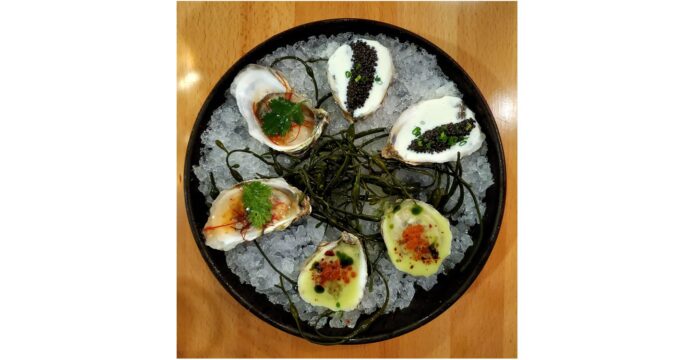
During its first life, the restaurant Sagaponack, in the Flatiron District, featured a menu you would expect to find in any eastern Long Island shore town, including the one it is named after: a raw bar, lobster roll, mussels. Despite garnering little notice from the food media, Sagaponack managed to hold its own.
When it closed in May of 2020, as so many restaurants did thanks to the pandemic, Sagaponack underwent a behind-the-scenes shakeup. Kyung il Lee, who had overseen operations at the Michelin-starred JeJu Noodle Bar, became a managing partner and in that capacity was tasked with reimagining the restaurant’s menu and philosophy. Ultimately, he brought in Phil Choy (BouludSud) as executive chef and the two set to work reinventing and refining. The bill of fare they ultimately engineered and now turn out nightly is well-executed and highly imaginative. At times it is transporting.
Fully a third of the menu is given over to oysters offered up in varying stages of cookery, from raw to roasted. Although the raw category features Big Rocks, rarely seen in these parts but prized for their plump meat and sweet, minerally finish, the real heat (pun intended) lay in the “dressed” and “roasted” offerings.
The most compelling of the dressed oysters is the one that is joined in its half-shell by minced cucumber, dill, and the fermented Japanese condiment yuzu kosho. A perky blend of Thai chili, lime, and chili thread is also available to help the oysters go down, as is a combination of buttermilk and Adamas Siberian Caviar, which imparts a velvety mouth feel while adding richness and salinity. If I have one quibble, it’s that the buttermilk is meted out with too heavy a hand, relegating the oyster to a supporting, rather than starring, role.
Among the roasted oysters, you will find a variant that, true to the restaurant’s East-meets-Mediterranean ethos, evokes a southern Italian pasta, marrying squid ink and ‘nduja with togarashi and a seaweed crumble. Alternately, a gochujang butter combined with serrano, sesame breadcrumb, and scallion lends a nice flavor boost to the oyster.

Non-oyster first courses include an impeccably fresh fluke tartare garnished with chopped Marcona almonds and specks of bright red tobiko. A colorful moat of coconut milk dotted with cilantro oil, chili oil, and lime is poured from a small pitcher at tableside — a visual and culinary tour de force.

The kitchen turns out a refreshing and creamy squash soup, its natural sweetness amplified by a drizzle of ginger coconut cream. Toasted pumpkin seeds and grains of aleppo pepper add texture and mild heat respectively.

Another study in flavor and texture is provided by Brussels sprouts that have been handsomely charred, then dressed with maple syrup, soy, diced apple, and sesame seeds. The kitchen delivers a terrific gambas al ajillo in which the garlicky oil that moistens the dozen or so shrimp is flavored not only with a healthy dose of smoked Spanish paprika but preserved lemon. Slabs of grilled sourdough are provided for mopping up the delicious sauce.

Chef Choy cooks a salmon fillet dressed in a mixture of butter and soy that has been reduced to the beurre noir stage, yielding a salty, pleasantly acidic base. The resulting dish, shoyu salmon, is served on a foundation of fragrant jeweled rice threaded with bits of oyster mushroom.

Plump Dayboat scallops are assiduously caramelized, then presented above a mound of buttery polenta dotted with maitakes. Small tide pools of a concentrated chicken jus add complexity to the dish’s flavor profile.

Thai milk cake, the lone dessert some nights, features rectangular slabs of an airy sponge that have been moistened by chunks of mango fruit and its nectar. The cake layers are mortared by an abundance of thick whipped cream and garnished by a cinnamon-pecan crumble.

The décor of the bilevel space that Sagaponack calls home is, like the food, a refreshing departure from the chowder house archetype. The planked floor is the color of weathered wood, and the walls — a deep, oceanic blue on the bottom, white on top — afford a subtle reminder of the horizon at the seashore on a calm day. Nautical accents are present, but they too are applied with restraint. Witness the sailor’s knots anchoring the milk-glass sconces that illuminate the room.
Price range: Oysters (per piece)—$4 to $6; starters—$11 to $22; plates —$23 to $35; desserts—$12 to $17.
Sagaponack, 4 W. 22nd Street, 212-229-2226, is open Monday through Friday for lunch and dinner, and Saturdays for brunch and dinner.
















